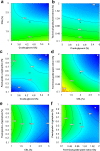Large scale production of indole-3-acetic acid and evaluation of the inhibitory effect of indole-3-acetic acid on weed growth
- PMID: 34158557
- PMCID: PMC8219710
- DOI: 10.1038/s41598-021-92305-w
Large scale production of indole-3-acetic acid and evaluation of the inhibitory effect of indole-3-acetic acid on weed growth
Abstract
Indole-3-acetic acid (IAA) is the most common plant hormone of the auxin class and regulates various plant growth processes. The present study investigated IAA production by the basidiomycetous yeast Rhodosporidiobolus fluvialis DMKU-CP293 using the one-factor-at-a-time (OFAT) method and response surface methodology (RSM). IAA production was optimized in shake-flask culture using a cost-effective medium containing 4.5% crude glycerol, 2% CSL and 0.55% feed-grade L-tryptophan. The optimized medium resulted in a 3.3-fold improvement in IAA production and a 3.6-fold reduction in cost compared with those obtained with a non-optimized medium. Production was then scaled up to a 15-L bioreactor and to a pilot-scale (100-L) bioreactor based on the constant impeller tip speed (Vtip) strategy. By doing so, IAA was successfully produced at a concentration of 3569.32 mg/L at the pilot scale. To the best of our knowledge, this is the first report of pilot-scale IAA production by microorganisms. In addition, we evaluated the effect of crude IAA on weed growth. The results showed that weed (Cyperus rotundus L.) growth could be inhibited by 50 mg/L of crude IAA. IAA therefore has the potential to be developed as a herbicidal bioproduct to replace the chemical herbicides that have been banned in various countries, including Thailand.
Conflict of interest statement
The authors declare no competing interests.
Figures







Similar articles
-
Indole-3-acetic acid production by newly isolated red yeast Rhodosporidium paludigenum.J Gen Appl Microbiol. 2015;61(1):1-9. doi: 10.2323/jgam.61.1. J Gen Appl Microbiol. 2015. PMID: 25833674
-
Indole-3-acetic acid biosynthetic pathways in the basidiomycetous yeast Rhodosporidium paludigenum.Arch Microbiol. 2016 Jul;198(5):429-37. doi: 10.1007/s00203-016-1202-z. Epub 2016 Feb 22. Arch Microbiol. 2016. PMID: 26899734
-
Biosynthetic Pathway of Indole-3-Acetic Acid in Basidiomycetous Yeast Rhodosporidiobolus fluvialis.Mycobiology. 2019 Jul 15;47(3):292-300. doi: 10.1080/12298093.2019.1638672. eCollection 2019. Mycobiology. 2019. PMID: 31565465 Free PMC article.
-
Indole-3-acetic acid: A widespread physiological code in interactions of fungi with other organisms.Plant Signal Behav. 2015;10(8):e1048052. doi: 10.1080/15592324.2015.1048052. Plant Signal Behav. 2015. PMID: 26179718 Free PMC article. Review.
-
The excessive production of indole-3-acetic acid and its significance in studies of the biosynthesis of this regulator of plant growth and development.Plant Cell Physiol. 1996 Dec;37(8):1043-8. doi: 10.1093/oxfordjournals.pcp.a029051. Plant Cell Physiol. 1996. PMID: 9032962 Review.
Cited by
-
Analysis of the Propionate Metabolism in Bacillus subtilis during 3-Indolacetic Production.Microorganisms. 2022 Nov 28;10(12):2352. doi: 10.3390/microorganisms10122352. Microorganisms. 2022. PMID: 36557605 Free PMC article.
-
Exploring Exogenous Indole-3-acetic Acid's Effect on the Growth and Biochemical Profiles of Synechocystis sp. PAK13 and Chlorella variabilis.Molecules. 2023 Jul 19;28(14):5501. doi: 10.3390/molecules28145501. Molecules. 2023. PMID: 37513371 Free PMC article.
-
Plant growth promotion and biocontrol properties of a synthetic community in the control of apple disease.BMC Plant Biol. 2024 Jun 13;24(1):546. doi: 10.1186/s12870-024-05253-8. BMC Plant Biol. 2024. PMID: 38872113 Free PMC article.
-
Plant growth-promoting bacteria from Uzungöl forest stimulate rice growth via seed biopriming and root inoculation: isolation and functional characterization of potent PGPR strains from rhizosphere soils of different trees.Front Plant Sci. 2025 Jul 24;16:1622951. doi: 10.3389/fpls.2025.1622951. eCollection 2025. Front Plant Sci. 2025. PMID: 40777060 Free PMC article.
-
Simultaneous organic/inorganic phosphate solubilization by Staphylococcus succinus NG-9 under saline-alkali conditions: Insights into its characteristics, mechanisms, and potential applications.Microbiol Spectr. 2025 Sep 2;13(9):e0049025. doi: 10.1128/spectrum.00490-25. Epub 2025 Jul 31. Microbiol Spectr. 2025. PMID: 40744838 Free PMC article.
References
-
- Gharde Y, Singh PK, Dubey RP, Gupta PK. Assessment of yield and economic losses in agriculture due to weeds in India. Crop Prot. 2018;107:12–18. doi: 10.1016/j.cropro.2018.01.007. - DOI
-
- Oerke EC. Crop losses to pests. J. Agric. Sci. 2006;144:31–43. doi: 10.1017/S0021859605005708. - DOI
-
- Délye C. Weed resistance to acetyl coenzyme A carboxylase inhibitors: An update. Weed Sci. 2005;53:728–746. doi: 10.1614/WS-04-203R.1. - DOI
-
- Bailey, K. L. The bioherbicide approach to weed control using plant pathogens. In Integrated Pest Management: Current Concepts and Ecological Perspective (ed Dharam P. Abrol) 245–266 (Academic Press, 2014).
Publication types
MeSH terms
Substances
Supplementary concepts
LinkOut - more resources
Full Text Sources

